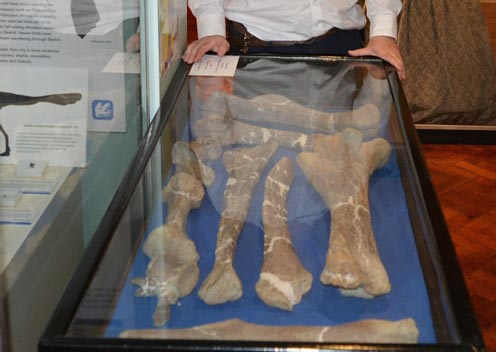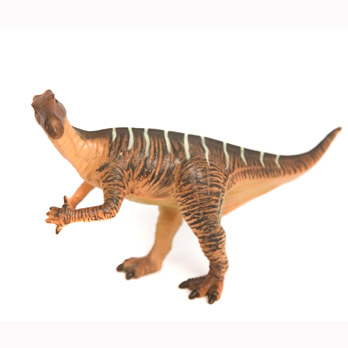Rare Hypselospinus On Show at Bexhill Museum
Dinosaur Fossils Go on Display at Local Museum
Iconic locations such as the Badlands of Montana, the Hell Creek Formation and the exotic sounding Tendaguru Beds are the sort of places that most people would associate with spectacular dinosaur discoveries, but residents of East Sussex (southern England), don’t have to travel too far to explore life in the past. The fossilised remains of a large, plant-eating dinosaur have just gone on display at Bexhill Museum. The bones not only represent a dinosaur, but one of the most successful kinds of dinosaur, or indeed, any land vertebrate that has ever existed.
Hypselospinus Fossils
Say hello to Hypselospinus (Hypselospinus fittoni), a member of the Iguanodon-like group of dinosaurs, (Iguanodontia clade), fossils of which have been found all over the world. Plant-eating dinosaurs such as the iguanodontids existed on our planet from the Middle Jurassic right up to the end of the Cretaceous, that’s a time span of some ninety million years or so.
Putting things into context, the Bexhill Museum specimen represents a type of herbivorous dinosaur the like of which roamed Earth over a period of time some four hundred times longer than our own species has existed. Hypselospinus was a medium sized iguanodontid, it may not have been the largest of its kind, but with an estimated length of six metres and a body mass perhaps around the two tonnes mark, Hypselospinus was a sizeable beast!
Fossils on Display at the Museum
Picture credit: Bexhill-on-Sea Observer
Hypselospinus fittoni
Hypselospinus (H. fittoni) is known from a variety of post cranial fossil material, all of it (we think), found in East Sussex. The Hypselospinus fossils on display at Bexhill Museum consist of a number of limb bones and other material such as a beautifully preserved caudal vertebra (tail bone). Local palaeontologists Peter and Joyce Austen are credited with the discovery, but it was David Brockhurst, an amateur fossil hunter, perhaps most famous for his work on Europe’s smallest known dinosaur, the curious “Ashdown Maniraptoran” who was responsible for the excavation.
The independent, voluntarily-run museum located in Egerton road, just an Argentinosaurus length away from the picturesque sea front, has a number of important fossils found in the local area on display. It might be difficult for residents of Bexhill-on-Sea to believe, but back in the Early Cretaceous this part of England was home to a variety of dinosaurs and also flying reptiles (Pterosaurs).
An Iguanodontid
Hypselospinus was typical of an iguanodontid. It had a rectangular shaped skull, which ended in a broad muzzle with a beak that was well suited to cropping vegetation. It spent most of its life ambling around on all fours, but it could, if it so wished, rear up onto its powerful back legs and adopt a bipedal stance. Large neural spines associated with the dorsal vertebrae (back bones) suggest that Hypselospinus had a steeply arching back, this feature distinguishes this dinosaur from other iguanodontids associated with southern England.
A Model of a Typical Iguanodontid (Iguanodon)
Picture credit: Everything Dinosaur
To view models and replicas of iguanodontids and other Early Cretaceous dinosaurs: CollectA Prehistoric Life Figures.
The Bexhill Hypselospinus
The Bexhill Hypselospinus fossils are being written up by Dr David Norman (Cambridge University), a palaeontologist who has studied a number of iguanodontid species and even has a plant-eating dinosaur, possibly another type of iguanodontid, but this time one that roamed China a few million years after Hypselospinus existed, named after him (Equijubus normani). We look forward to reading Dr Norman’s appraisal of the Bexhill material.
Bexhill Museum curator, Julian Porter commented:
“We have got most of the parts, including the arms and legs. One thing which is missing, however is the “thumb spike”. Either we have not looked in the right place or it may be that this particular species didn’t have the thumb spike like other Iguanodonts.”
Perhaps, Everything Dinosaur can help to clear up the “thumb spike” issue, the Natural History Museum (London), has within its extensive ornithischian dinosaur collection a partial right forearm with an thumb spike measuring around eight centimetres in length. This specimen (NHMUK R1832) has been assigned to Hypselospinus fittoni.
Checking Details in a Book
It’s a good job we had our “Dinosaurs of the British Isles” book (Dean Lomax and Nobumichi Tamura), handy to cross reference our notes on Hypselospinus fossil material.
If this is correct, than just like the more famous Iguanodon, Hypselospinus had a thumb spike, this spike probably served as a defensive weapon, very helpful, as large meat-eating dinosaurs also roamed around this part of East Sussex during the Early Cretaceous.
To learn more about Bexhill Museum: Bexhill Museum.
To read more about the “Ashdown Maniraptoran”, the cervical vertebra of which is on display at the museum: Europe’s Smallest Dinosaur.



